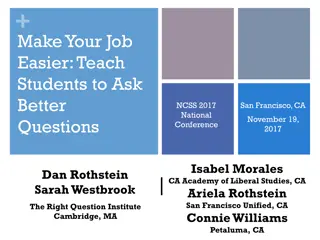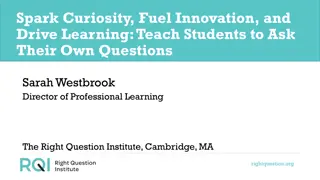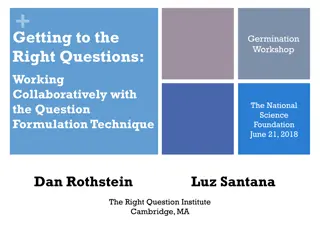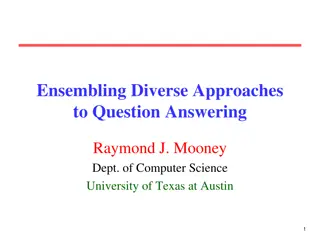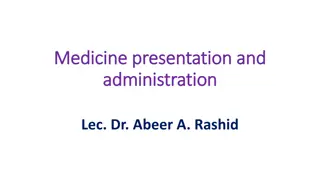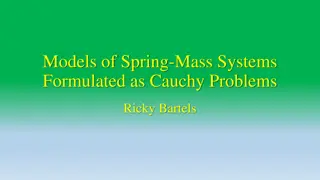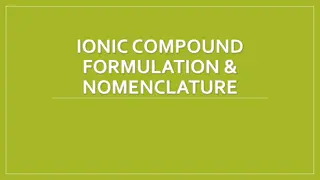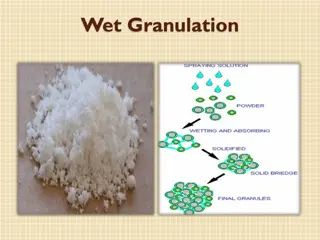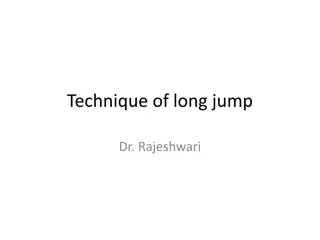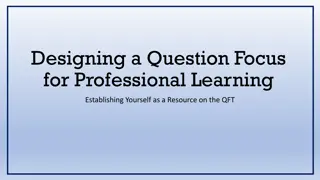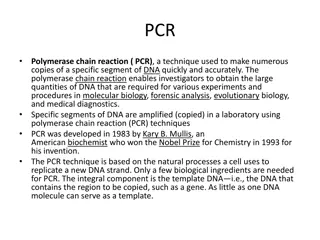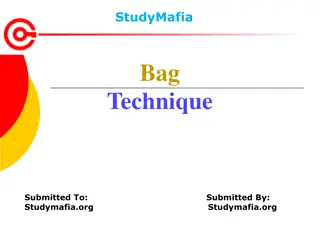Enhancing Learning Through Question Formulation Technique (QFT)
Sarah Westbrook, Director of Professional Learning at The Right Question Institute, explores the importance of teaching question formulation skills. The session covers the benefits of QFT in collaborative learning, real classroom examples, and why questioning is crucial now. Learn how to access free QFT resources and why it's essential to teach students the art of asking questions. The agenda includes discussions on the impact of questioning on learning, inspired by quotes from Feynman and Firestein, emphasizing the role of questions in education.
Download Presentation

Please find below an Image/Link to download the presentation.
The content on the website is provided AS IS for your information and personal use only. It may not be sold, licensed, or shared on other websites without obtaining consent from the author. Download presentation by click this link. If you encounter any issues during the download, it is possible that the publisher has removed the file from their server.
E N D
Presentation Transcript
An Experience in the Question Formulation Technique (QFT) Sarah Westbrook Director of Professional Learning The Right Question Institute Cambridge, MA Sarah.westbrook@rightquestion.org rightquestion.org
To Access Todays Materials: bit.ly/3uyfykC
Access RQIs Free QFT Resources https://rightquestion.org/education/resources Classroom Examples Instructional Videos Planning Tools & Templates
Use and Share These Resources The Right Question Institute offers materials through a Creative Commons License. You are welcome to use, adapt, and share our materials for noncommercial use, as long as you include the following reference: Source: The Right Question Institute (RQI). The Question Formulation Technique (QFT) was created by RQI. Visit rightquestion.org for more information and free resources.
Todays Agenda 1) Welcome 2) Why Spend Time on Teaching the Skill of Question Formulation? 3) Collaborative Learning with the Question Formulation Technique (QFT) 4) Explore Real Classroom Examples & Applications 5) Why is Question Formulation Important Now? 6) Q&A
+ Why spend time teaching the skill of question formulation?
Honoring the Original Source: Parents in Lawrence, Massachusetts, 1990 We don t go to the school because we don t even know what to ask.
"There is no learning without having to pose a question." - Richard Feynman Nobel Laureate, Physics, 1965
We must teach students how to think in questions, how to manage ignorance. Stuart Firestein Former chair, Department of Biology, Columbia University
College Presidents on What College Students Should Learn The primary skills should be analytical skills of interpretation and inquiry. In other words, know how to frame a question. - Leon Botstein, President of Bard College the best we can do for students is have them ask the right questions. - Nancy Cantor, Former Chancellor of University of Illinois The New York Times, August 4, 2002
Yet, Only 27% of Graduates Believe College Taught Them How to Ask Their Own Questions Alison Head, Project Information Literacy at University of Washington, 2016
But, the problem begins long before college
Question Asking Declines with Age Tizard, B., Hughes, M., Carmichael, H., & Pinkerton, G. (1983). Pearson, J.C. & West, R. (2009)
We can work together on creating more opportunities for students to ask their own questions
We Are Not Alone More than 1 million classrooms worldwide
What happens when students do learn to ask their own questions?
Research Confirms the Importance of Questioning Self-questioning (metacognitive strategy): Student formulation of their own questions is one of the most effective metacognitive strategies Engaging in pre-lesson self-questioning improved students rate of learning by nearly 50% (Hattie, p.193) John Hattie Visible Learning: A Synthesis of Over 800 meta-Analyses Relating to Achievement, 2008
Student Reflection The way it made me feel was smart because I was asking good questions and giving good answers. -Boston 9th grade summer school student
Todays Agenda 1) Welcome & Community Building 2) Why Spend Time on Teaching the Skill of Question Formulation? 3) Collaborative Learning with the Question Formulation Technique (QFT) 4) Explore Real Classroom Examples & Applications 5) Why is Question Formulation Important Now? 6) Q&A
+ Collaborative Learning with the Question Formulation Technique (QFT)
The Question Formulation Technique (QFT) Individuals learn to: Produce their own questions Improve their questions Strategize on how to use their questions Reflect on what they have learned and how they learned it
Rules for Producing Questions 1. Ask as many questions as you can 2. Do not stop to answer, judge, or discuss 3. Write down every question exactly as stated 4. Change any statements into questions
Produce Questions 1. Ask Questions 2. Follow the Rules Ask as many questions as you can. Do not stop to answer, judge, or discuss. Write down every question exactly as it was stated. Change any statements into questions. 3. Number the Questions
Question Focus Some students are not asking questions. Now, ask questions. Number the questions. Follow the rules: Ask as many questions as you can. Don t stop to answer, judge, or discuss. Record each question exactly as it was stated (or first came to mind). Change any statements into questions.
Categorize Questions: Closed/Open Definitions: Closed-ended questions can be answered with a yes or no or with a one-word answer. Open-ended questions require more explanation. Directions: Identify your questions as closed-ended or open-ended by marking them with a C or an O.
Discuss Closed-ended Questions Disadvantages Advantages
Discuss Open-ended Questions Advantages Disadvantages
Improve Questions Take one closed-ended question and change itinto an open-ended question. Closed Open Take one open-ended question and change itinto a closed-ended question. Closed Open Add these as new questions to your list
Prioritize Questions Review your list of questions Choose three questions that you feel are most important. While prioritizing, think about your Question Focus, Some students are not asking questions. Then, think about why you chose those questions.
Action Plan Moving from priority questions into action steps. In order to answer your priority questions: What do you need to know? Information What do you need to do? Tasks Write down a couple ideas you have.
Share 1. Your priority questions 2. Any highlights from your action plan 3. The numbers of your three priority questions in your original sequence (For ex: 2, 4, 7 out of 8 total )
Reflect What did you learn? How did you learn it? How could you use it in your work?
The QFT, on one slide 1. Ask as many questions as you can 2. Do not stop to discuss, judge or answer 3. Record exactly as stated 4. Change statements into questions 1) Question Focus 2) Produce Your Questions Follow the rules Number your questions 3) Improve Your Questions Categorize questions as Closed or Open-ended Change questions from one type to another 4) Strategize Prioritize your questions Action plan or discuss next steps Share 5) Reflect Closed-Ended: Answered with yes, no or one word Open-Ended: Require longer explanation Source: The Right Question Institute rightquestion.org
Three thinking abilities with one process
Thinking in many different directions Divergent Thinking
Narrowing Down, Focusing Convergent Thinking
Thinking about Thinking Metacognition
Todays Agenda 1) Welcome & Community Building 2) Why Spend Time on Teaching the Skill of Question Formulation? 3) Collaborative Learning with the Question Formulation Technique (QFT) 4) Explore Real Classroom Examples & Applications 5) Why is Question Formulation Important Now? 6) Q&A
+ Exploring Classroom Examples
Classroom Example: Kindergarten Teacher: Catherine Tommasello, Marietta, GA Topic: How can we make our school playground more inviting for all? Purpose: To launch kindergarten Project Based Learning (PBL) unit
Question Focus https://www.loc.gov/item/2014693976/
Student Questions 1. Is this a safe activity? 2. Where are the boys? 3. What are they swinging on? 4. Why are there buildings? 5. Where is the teacher? 6. Don t they have any grass? 7. Is that fence safe? It has spikes on top 8. Why can t that kid come inside? 9. Why do those kids have tights on? 10.Why is there a truck with hay on it? 11.Why do they have a fence? 12.Did anyone get hurt playing this game? 13.Do they have a PAWS promise? 14.Where is their mom and dad? 15.What does that sign say? 16.What happens after it rains? 17.Why don t they invited that kid to play?
Next Steps with Student Questions Students made a Venn Diagram to compare the playground from the past to their own playground. What is inviting about both? What is uninviting about the playground from the past? What is uninviting about our playground? Students compiled their findings and shared them with other Kindergarten classes. This research helped them further investigate their driving question
Classroom Example:4th Grade Teacher: Deirdre Brotherson, Hooksett, NH Topic: Math unit on variables Purpose: To engage students at the start of a unit on variables and assess their current skill level
Question Focus 24 = + +
Student Questions 1. Why is the 24 first? 2. What do the smiley faces mean? 3. Why are there 3 smiley faces? 4. How am I suppose to figure this out? 5. Is the answer 12? 6. Can I put any number for a smiley face? 7. Do three faces mean something? 8. Do the numbers have to be the same because the smiley faces are the same? 9. What numbers will work here? 10. Does it mean 24 is a really happy number? 11. Can we replace each smiley face with an 8? 12.Do any other numbers work? 13.Can we do this for any number? 14.Does it always have to be smiley faces? 15.Do we always have to use three things?
Next Steps Posters of students questions were displayed on walls around the room As students learned more about variables, they went up to the wall to cross off questions they had answered At the end of the unit, students discussed what they had learned and what questions they now had
Classroom Example: 6th Grade Teacher: Megan Harvell, Boston, MA Topic: The Civil War Purpose: Pre-reading activity to engage students


